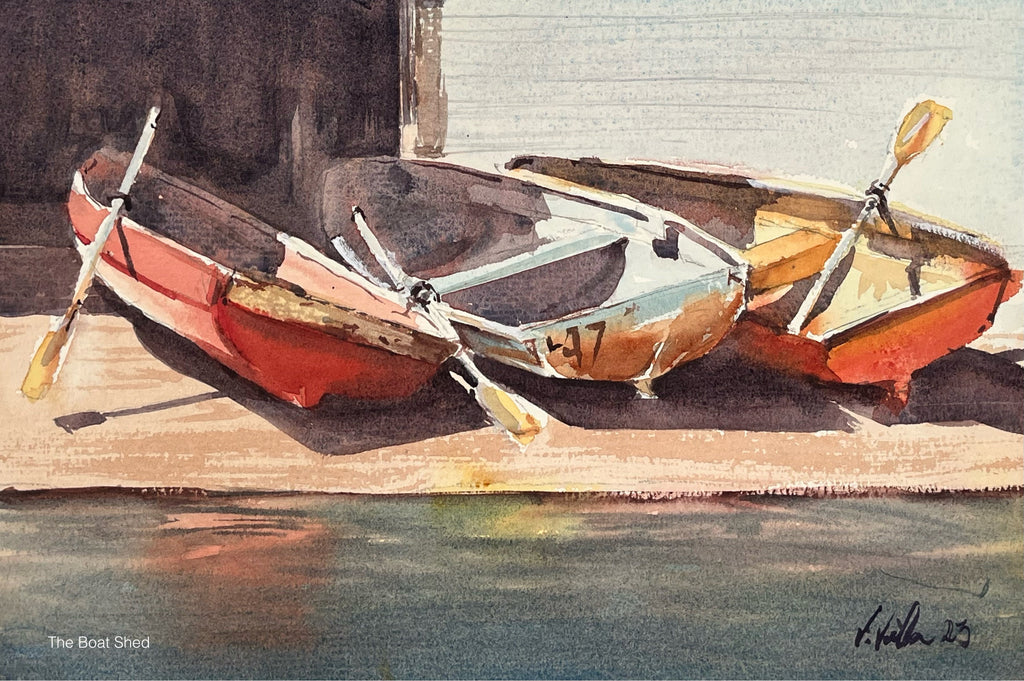Luminosity Exhibition - Painting process

Blog Post from the Dragon’s Lair Gallery exhibition Luminosity. Hurstville Museum and Gallery
Can you give us an insight into your artistic process? Is your work pre-planned or created intuitively? How long does each work take to complete?
Throughout my day, I will gather information by taking photos, making notes of any colours and interesting shapes that I see. All of these elements come together when I decide what I want to paint. For some pictures, I feel a sense of urgency to get started on them right away. Other images or concepts I like to hold onto and contemplate for a long time.Although execution in watercolour can happen quickly, a significant amount of time and energy goes into preparation. Before beginning a final piece, I usually paint a small sketch in my book and make notes about colours. This sketch may stay in the book and be painted later depending on how I feel and the time available.

The next time I paint the image, I create a small rough on watercolour paper. Sometimes I plan the colours, but other times I just go by feel and make notes about what to change next time. This stage is always quick and expressive, with lots of mistakes.

For the final piece, I take more time to plan and slow down the process. Sometimes, these pictures are painted in stages over a couple of days, but other times it's completed in one sitting. The final piece tends to be a quarter sheet, about 23 x 28cm, which is still a relatively small picture.


Can you explain your technique; how you manipulate the medium?
Painting in watercolour allows you to create a sense of transparency, luminosity, and fluidity that is difficult to replicate with any other medium. One of the most important things to remember is that it is a transparent medium. This means that the white of the paper will be the brightest and lightest colour in a painting. Work is done in layers, starting with the lightest colours and gradually building up to the darker ones.
Wetting the paper before beginning to paint can help the colours spread more easily and create a soft, blurred effect. After the first layer has dried, you continue to add more layers, gradually building up the depth and complexity of the painting. Using different brushes and techniques will create different effects. For example, a dry brush technique will add texture to the painting and provide a balance of hard and soft edges.
Do you keep some kind of ongoing drawing book or diary? Or a collection of images or photographs for inspiration?
Keeping a drawing book is an important part of my practice. It’s a great way to keep a record of my ideas and to help improve my skills over time. Whenever I draw, I make notes of the colours I use, techniques I tried and any other useful notes for future reference. It helps me to remember what I did, but it can also inspire new ideas for future paintings.
I do take a lot of photos which is a great way to capture the exact image I need, and shows various lighting and composition. I always make sure to take a variety of shots from different angles and in different lighting conditions. One of the most important tools for me is having my own reference material.
Who are your favourite artists? Who do you draw inspiration from?
As a graphic designer I have always been interested in illustration work, all forms of calligraphy, paper crafts, Japanese wood block prints and Chinese brush paining. I took up Chinese brush painting as a hobby so that I would have time away from the computer and I think it was a natural transition into the watercolour work that I am doing now.
Studying the works of many different artists, allows you to gain insight into different techniques, styles, and approaches, and use this knowledge to create something unique.
